New close-up images of a region near Pluto’s equator reveal a giant surprise — a range of youthful mountains rising as high as 11,000 feet (3,500 meters) above the surface of the icy body. Credits: NASA/JHU APL/SwRI
Story/photos expanded[/caption]
APPLIED PHYSICS LABORATORY, LAUREL, MD – Scientists leading NASA’s historic New Horizons mission to the Pluto system announced the first of what is certain to be a tidal wave of new discoveries, including the totally unexpected finding of young ice mountains at Pluto and crispy clear views of young fractures on its largest moon Charon, at a NASA media briefing today (July 15) at the Applied Physics Laboratory (APL) in Laurel, Maryland.
A treasure trove of long awaited data has begun streaming back to Mission Control at Johns Hopkins University Applied Physics Laboratory to the mouth watering delight of researchers and NASA.
With the first ever flyby of Pluto, America completed the initial up close reconnaissance of the planets in our solar system. Pluto was the last unexplored planet, building on missions that exactly started 50 years ago in 1965 when Mariner IV flew past Mars.
“Pluto New Horizons is a true mission of exploration showing us why basic scientific research is so important,” said John Grunsfeld, associate administrator for NASA’s Science Mission Directorate in Washington.
“The mission has had nine years to build expectations about what we would see during closest approach to Pluto and Charon. Today, we get the first sampling of the scientific treasure collected during those critical moments, and I can tell you it dramatically surpasses those high expectations.”
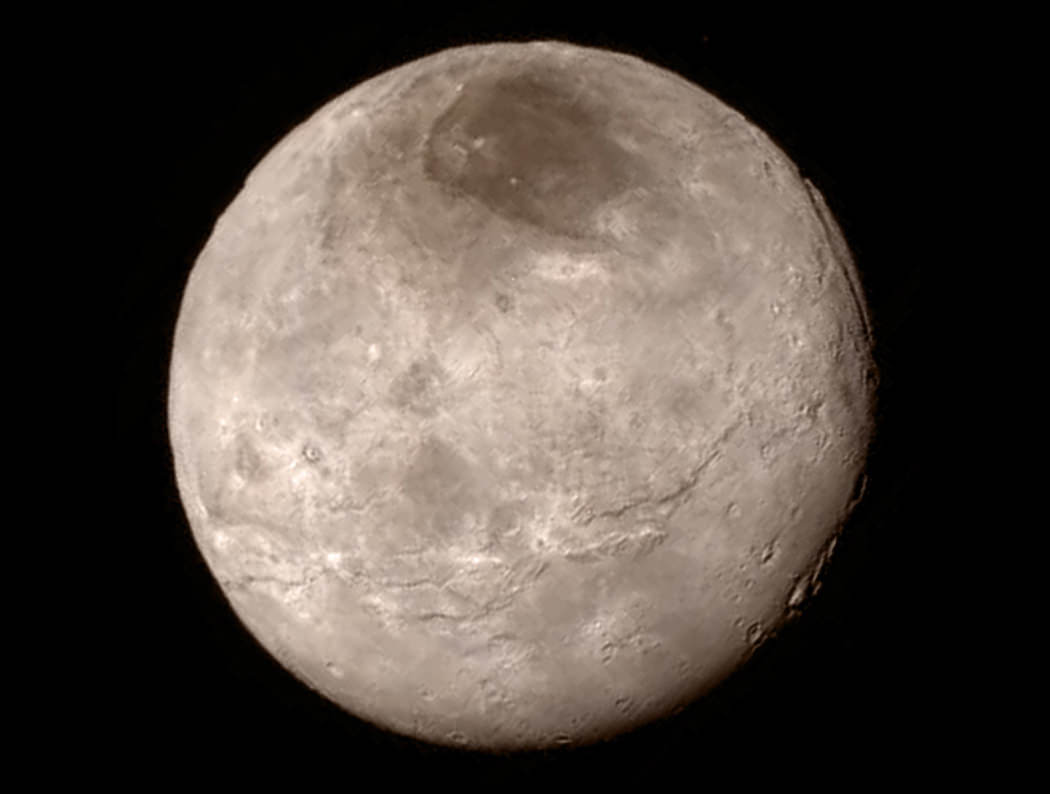
Today the team announced that New Horizons has already made a totally unexpected discovery showing clear evidence of ice mountains on Pluto’s surface in the bright area informally known as the ‘big heart of Pluto.’
The new close-up image released today showed an icy mountain range near the base of the heart with peaks jutting as high as 11,000 feet (3,500 meters) above the surface, announced John Spencer, New Horizons science team co-investigator at the media briefing.
“It’s a very young surface, probably formed less than 100 million years old,’ said Spencer. “It may be active now.”
Spencer also announce that the heart shaped region will now be named “Tombaugh Reggio” in honor of Clyde Tombaugh, the American astronomer who discovered Pluto in 1930.
“We are seeing water ice.”
“I never would have imagined this!” Spencer exclaimed.
“And I’m very surprised that there are no craters in the first high resolution images.”
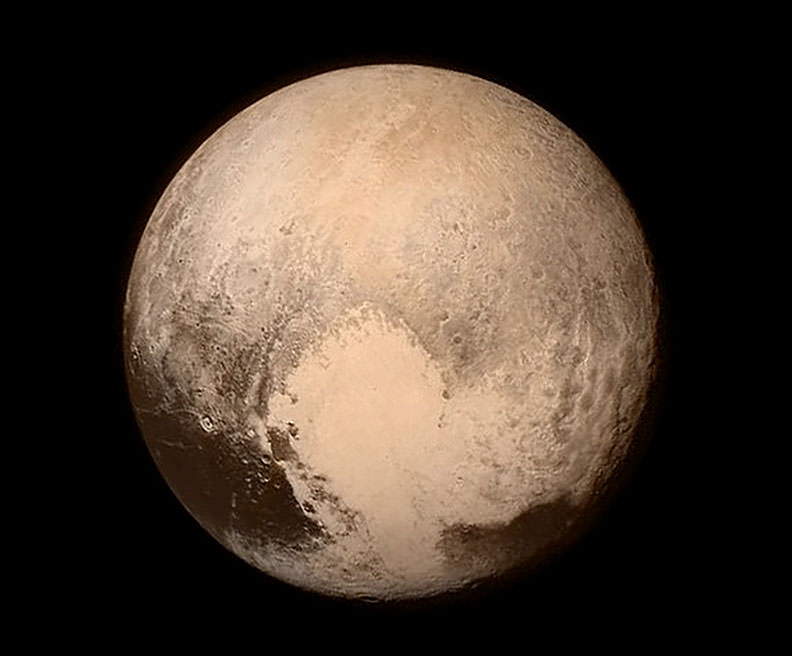
The finding of ice mountains has major scientific implications.
Unlike the icy moons of giant planets, Pluto cannot be heated by gravitational interactions with a much larger planetary body. Some other process must be generating the mountainous landscape, said the team.
“This may cause us to rethink what powers geological activity on many other icy worlds,” says Spencer of SwRI.
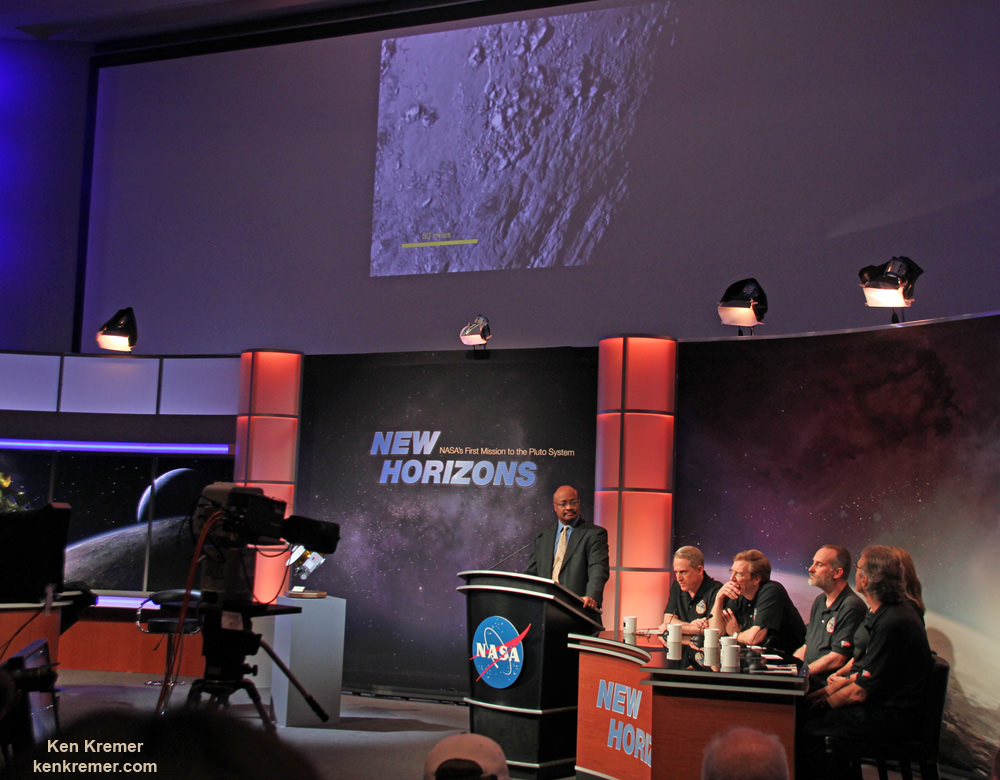
“Pluto may have internal activity. There may be geysers or cryovolcanoes,” New Horizons principal investigator Alan Stern of the Southwest Research Institute, Boulder, Colorado, said during the media briefing. However there is no evidence for them yet.
Additional high resolution images for “Tombaugh Reggio” area are being transmitted back to Earth today and will continue.
“Finding a mountain range of ice is a complete surprise,” Stern noted.
After a nine year voyage through interplanetary space, New Horizons barreled past the Pluto system on Tuesday, July 14 for a history making first ever flyby at over 31,000 mph (49,600 kph), and survived the passage by swooping barely 7,750 miles (12,500 kilometers) above the planet’s amazingly diverse surface.
The team had to wait another 12 hours for confirmation that the spacecraft lived through the daring encounter when signals were reacquired as planned at 8:53 p.m. EDT last night. Since New Horizons swung past Pluto to continue its voyage, the probe is now more than million miles outbound just 24 hours later.
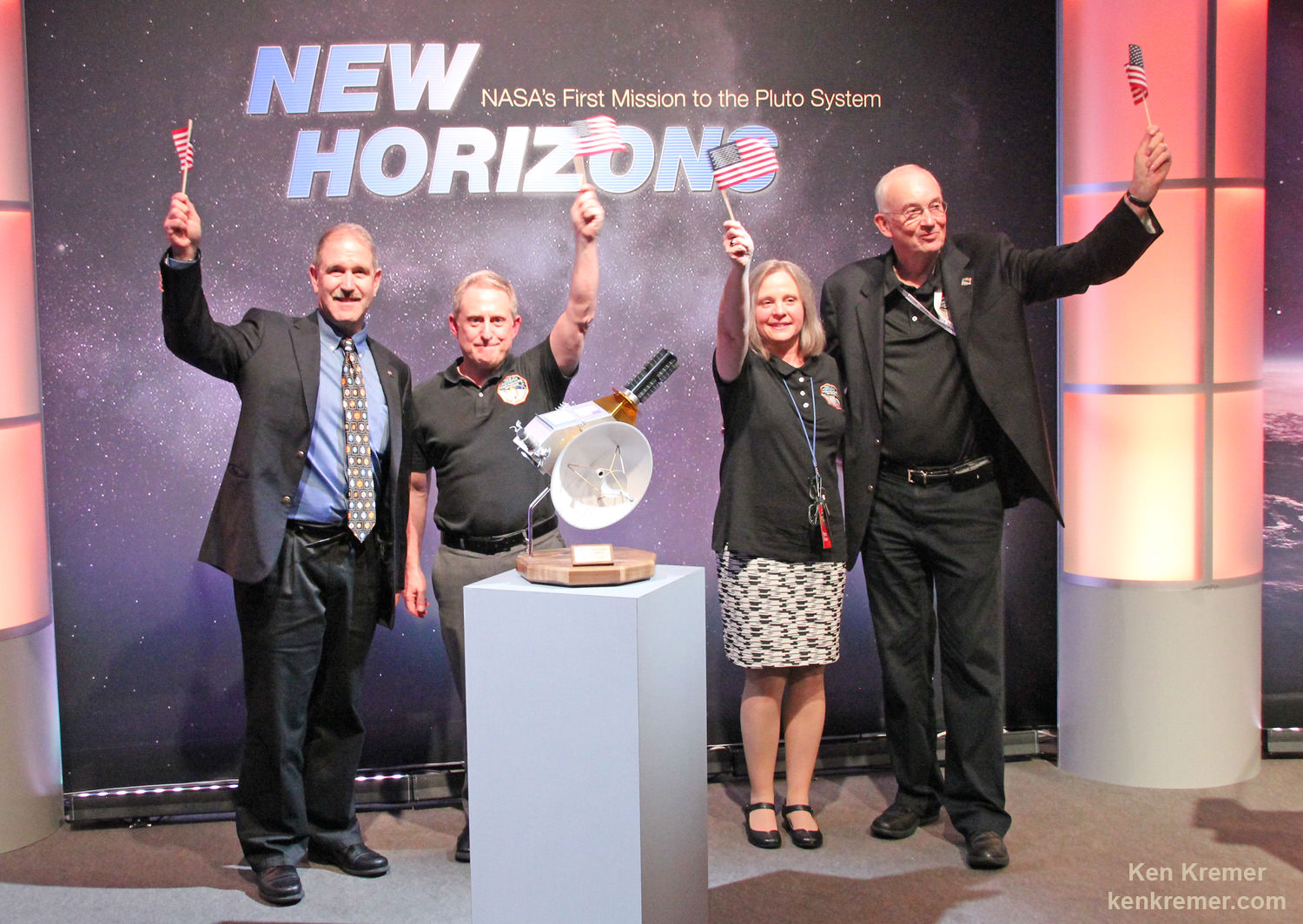
The New Frontiers spacecraft was built by a team led by Stern and included researchers from SwRI and the Johns Hopkins University Applied Physics Laboratory (APL) in Laurel, Maryland. APL also operates the New Horizons spacecraft and manages the mission.
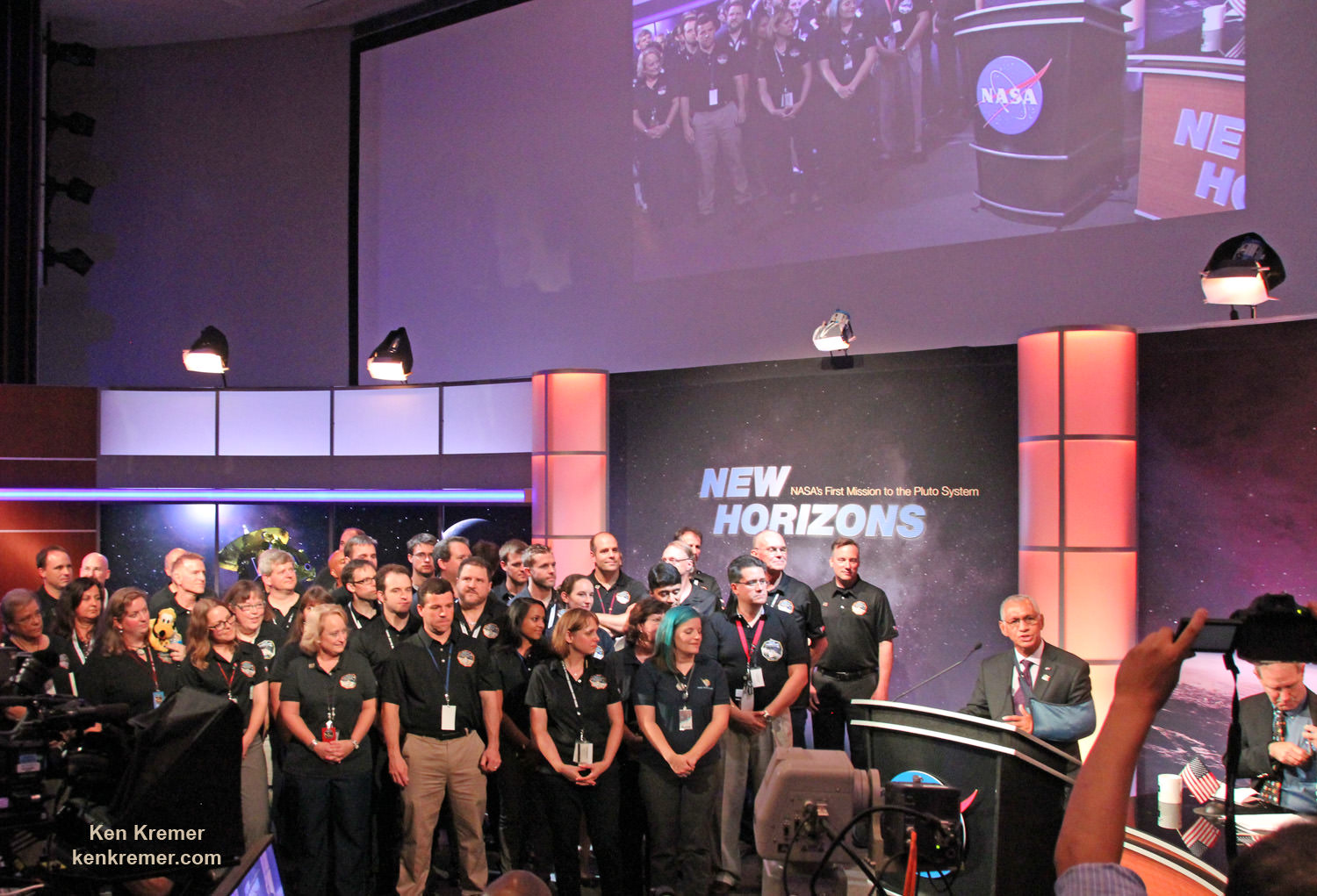
Watch for Ken’s continuing onsite coverage of the Pluto flyby on July 14 from the Johns Hopkins University Applied Physics Laboratory (APL).
Stay tuned here for Ken’s continuing Earth and planetary science and human spaceflight news.
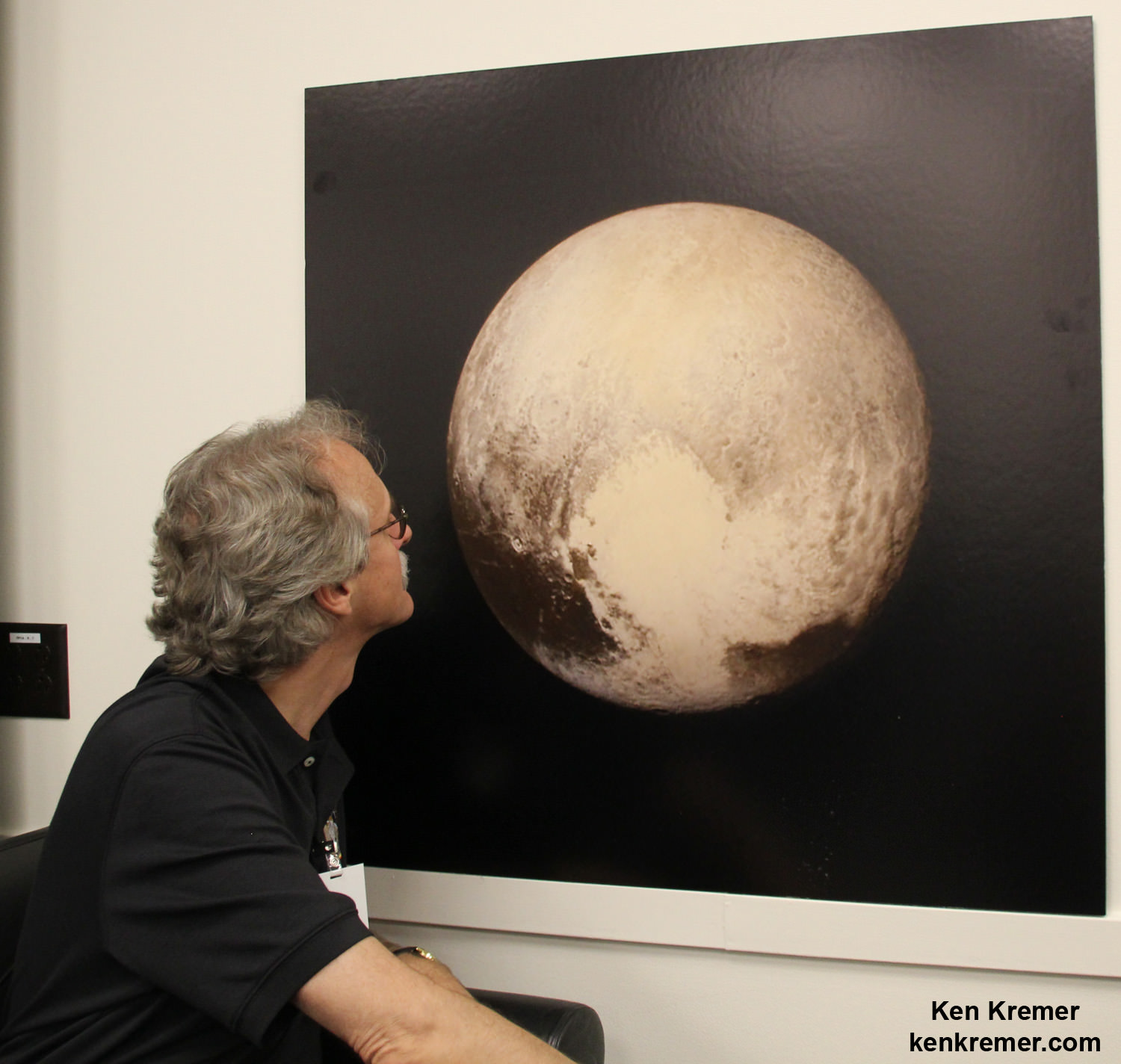

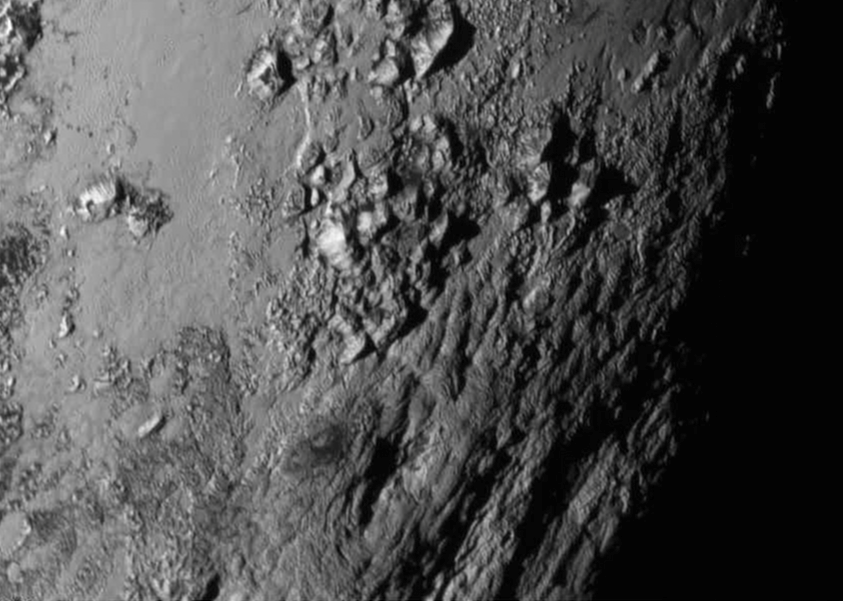
and sinking areas larger than the mountains??
Very cool!
With all these ices, why should we expect that a meteor strike would leave a crater like in the dust on our moon. Couldn’t the strike be the mysterious geological activity melting the surface, pushing up mountains and creating the smooth areas. Perhaps, the mountain terrain will reveal the clues to their creation.
Also, what if the meteor or asteroid was made of some frozen gas? This is not Kansas!
Nitrogen ice hitting nitrogen ice might not cause a crater as a rock hitting our rocky moon (or Kansas) does. Yes, I suppose geochemistry is a bit different out there.
From the 3pm briefing it sounds like the major struggle is understanding how Pluto and Charon can have young surfaces at least in some areas – the the traditional understanding of how much radioactive material is available in bodies with silicates at a mix with densities resolving with mostly water.
Or, and extraordinary claims require extraordinary evidence, the collision that created the Pluto system of moons and would severely reshape its surface, didn’t happen billions of years ago.
What would Gene Shoemaker do?
Thank you, Ken, and an enormous thanks to the entire New Horizons team!
This whole thing is simply mind boggling. Breathtaking! And there’s much more to come!
I wish we could know what Gene Shoemaker would say.
How many engineers do you know who could design and produce a space probe, ALL of which would last 9 1/2 years in the harsh environment of space?
Ken, thank you for your question to the panel last night, about what new things and ideas they had thought of or discovered over the past nine years. It was one of the best asked. It brought out some interesting comments from Dr. Stern.
Thanks Pete!! more upcoming!!
Wondering about the source of energy to create these features, and obviously planet and moon are tidally locked. But the barycenter is outside of Pluto itself. Is there a resulting gravity shear from this, that would work against Pluto’s own gravity and the elasticity of the materials involved? Or is that just too stable to get energy from.
These pictures are amazing!
s that what Pluto would look like we were actually there and seeing it with our own eyes? Or did they have to add a lot of brightness to it? It seems like it shouldn’t be nearly that bright.
I’m not sure but our eyes are great at adapting to darkness, I guess Pluto would be like Earth sometime in the evening. Hydra is actually as reflective as snow or white clouds. Maybe parts of Pluto’s varied landscape is too.
You would see good colour. Pluto is 30-45 AU from the sun, so it will get 1/900 to 1/2025 of the light level we get at earth. A very clear day may give us 100 000 lux, and an overcast day may be as low as 100. Indoor lighting may be about 50 lux.
Traditional film cinemas use an open-gate white level about 50 cd/m2. You can’t convert this to lux directly. However, suppose were surrounded by the screen so any surface was seeing a solid angle of 2.pi steradians, then you would be lit by about 300 lux. If we compensate for flare, for our cinema screen has a dark surround so there is less stray light within our eyes, then what we see in a cinema is perhaps not far from mid-day on Pluto: not the best light levels for colour vision, maybe, but enough to see ruby slippers, emerald cities, and yellow brick roads.
Pluto and Charon are constantly pulling at each other Similar to Earth and our Moon which causes our Ocean tides on Earth so is it possible that the ice surface of both Pluto and Charon are being altered by this constant battle and erasing any crater impacts that have happened could the ice be acting like our Continental Plates on Earth and altering their surfaces?
But Pluto and Charon are mutually tidally locked to each other. I’m pretty sure it is the only known system in the Solar system which has that configuration. Some use it as a criteria for defining a double planet. All the pulling has balanced out and settled into constant harmony. Or at least that was how almost everyone thought about it until yesterday. Maybe Pluto and Charon do rotate somewhat relative to each other? Maybe Pluto passively sublimates, slowly boiling off like a comet. Leaving mountains of the less volatile components.
The variety of planets and moons and comets is stunning. So what can we imagine about the exoplanets?
Thank you Far Away but there is no such thing as Constant Harmony in our Cosmos….. It Does NOT Exist because it is constantly evolving everywhere…..
Stern said that Charon and Pluto were no longer exchanging tidal energy. There may be small deviations but on the whole he is saying it is not a source of warming. This leaves people scratching their heads to explain the young surfaces as they believe there isn’t enough radioactive energy or energy of formation from the collision left.
I wonder if Pluto is spherical or elongated. I’d think it should be elongated. Maybe that will help them figure out of if there is an ocean…. Or for that matter Charon…
Btw, what is Fraser Cain doing these days at the end of the Solar system?
Can’t wait to see more images! i.e. What does the OTHER side of Pluto look like? I’ll take a long range image over no image, any time!
Mountains made of water ice.. Could they be fragments of a moon that ‘slow’ collided with Pluto? The slushy organic hydrocarbon ice surface hiding the crater in a relatively short time?
If we ever get around to naming these mountains, may I suggest that, given the connection between H.P. Lovecraft and Pluto (and astronomy, for that matter) perhaps the ‘Mountains of Madness’? In any event, fantastic job, New Horizons team! Everyone is proud of you, and congratulations!
KEN IS RIGHT, IT IS 8
http://i2.photobucket.com/albums/y33/HeadAroundU/KEN%20IS%20RIGHT%20IT%20IS%208.jpg